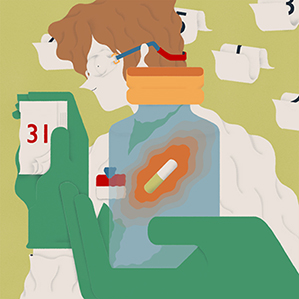Single-Dose Cures for Malaria, Other Diseases
One of the world’s preëminent biomedical researchers is calling for a concerted effort by scientists to develop pills that would stay in the stomach or gut for weeks or months once swallowed, delivering one or more drugs continuously or over set intervals.

Such “super pills” would greatly simplify the treatment of diseases such as malaria. They could address a major concern in medicine, says MIT professor Robert Langer: the fact that many people don’t take all their drugs, especially when undergoing long-term treatment.
In an invited column in this week’s issue of the journal Nature, he and his colleague Giovanni Traverso, a gastroenterologist and researcher at MIT, note that failure to keep up with drug treatments leads to about $100 billion a year in avoidable hospitalizations. In poor countries, compliance with treatment can be even lower. “We have a lot of great medicines, but under 50 percent of folks actually take them,” Traverso says.
Engineering a single pill to take the place of complex dosing regimens could be particularly important for malaria, which often requires multiple drugs over long periods. Failure to follow the right treatment can spread drug resistance, making the disease harder to eradicate. Traverso says the technology could also “revolutionize the standard of care” for psychiatric patients and those with Alzheimer’s and other forms of dementia, which make it difficult for patients to remember to take their medicine.
Researchers have been developing extended-release medications for decades, and some, such as birth-control implants, are on the market now. But the existing extended-release medicines that can be taken orally—the easiest and most preferred way—deliver drugs over hours, not weeks or months.
For 30 years researchers have investigated using special bioadhesives that could stick to the walls of the gastrointestinal tract, “but clinical success has been minimal,” Langer says. “There are some new approaches we are working on that hopefully will change that.” Langer and Traverso aren’t saying much about their new technology until they have patent protection. They’re focusing on super pills for malaria, with funding from the Bill and Melinda Gates Foundation. Traverso says that “the state of materials research is ripe for the development of such systems.”
The key will be developing materials that can withstand the harsh environment of the GI tract, whose function is to break things down and move them out rather than allow them to stay in place for months. Safety concerns are also paramount, since months’ worth of medication could be deadly if accidentally released all at once. There also need to be mechanisms for removing the pill or deactivating it if patients have adverse reactions.
But the GI tract is worth targeting because swallowing pills is so much easier than other dosing mechanisms. And whereas implants elsewhere in the body can trigger immune reactions, the gut tolerates foreign materials much more easily. “You can eat celery, no problem. But if you implant a piece of celery, I can assure you you’ll get a foreign-body reaction,” Traverso says.
In addition to using adhesives to keep pills in the GI tract, other options include designing pills that expand into mesh-like shapes once they hit the stomach, preventing them from leaving but allowing food to pass through. Another possibility being investigated is small spheres that produce carbon dioxide in the acidic environment of the stomach. That causes them to inflate and float, staying in place as long as there is fluid in the stomach. Meanwhile, an array of existing materials can gradually deteriorate and release drugs, or allow them to leak out slowly through pores. It’s also possible to design micromachines that deliver pulses of medication at intervals controlled by microchips.
One safety concern is that a device designed, say, for the stomach could fail and end up blocking the intestine. This might be addressed by engineering materials to fall apart as they encounter the intestinal environment, which is very different from the stomach. It may also be possible to communicate wirelessly with electronics embedded in a pill to deactivate it.
Traverso says the work is still “very early.” “This is an enormous challenge,” he says, “but it’s also an exciting opportunity.”
Keep Reading
Most Popular
How scientists traced a mysterious covid case back to six toilets
When wastewater surveillance turns into a hunt for a single infected individual, the ethics get tricky.
The problem with plug-in hybrids? Their drivers.
Plug-in hybrids are often sold as a transition to EVs, but new data from Europe shows we’re still underestimating the emissions they produce.
What’s next for generative video
OpenAI's Sora has raised the bar for AI moviemaking. Here are four things to bear in mind as we wrap our heads around what's coming.
Stay connected
Get the latest updates from
MIT Technology Review
Discover special offers, top stories, upcoming events, and more.